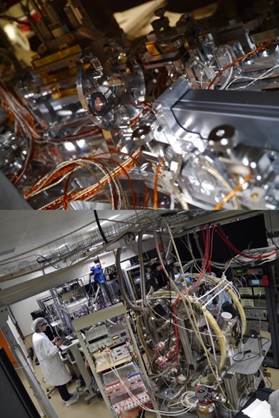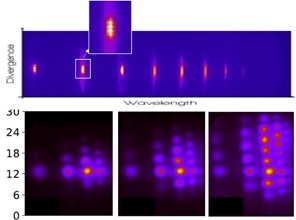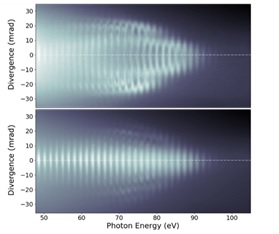|
Post-shaping XUV radiation High Harmonic Generation delivers a very wide spectrum of harmonics in the XUV range, made of a comb of the odd harmonics of the driving laser. Each individual harmonic lasts a fraction of the duration of the driving laser and is all the broader as the driving laser has a short duration. With ultimate single or few cycles driving pulses, it converges to a continuum spectrum, where several harmonics overlap spectrally and finally merge together. In the 10 kHz experimental room at Attolab, we designed a steady beamline to “post-shape” this harmonic beam, before delivering it through a free port available for external users. In brief we offer three working mode, with durations from about 100 as up to 10 fs, synchronized with a pump of 23 fs duration at λ =800 nm.This flexibility is achieved by inserting different XUV optics on the beam path. Switching from one mode to another takes about 15 minutes. This new equipment is being commissioned in 2018. Further information : attolab.fr People : David Bresteau, Carlo Spezzani, Julien Lenfant, David Denettierre (Soleil), François Pollack (Soleil), Maël Delhinger (IOGS), Franck Delmotte (IOGS), Thierry Ruchon (task leader). Funding : Equipex Attolab, coordinated by Bertrand Carré at LIDYL. Satellite projects : Opt2X from Paris-Saclay (coordination Danielle Dowek, Marino Marsi), Attolite (Coordination Pascal D’Oliveira at LIDYL) and Pulse-X (Coordination Danielle Dowek) from region Ile de France. |
 |
|
Shaping the driving field Generating harmonics with a single gaussian beam delivers, in smooth focusing conditions, a gaussian beam diverging slightly less than the driving beam. HHG is not only used to provide an ultimate source of ultrashort XUV pulses, but it is also a paradigmatic example of a highly non-linear process. As such, studies with non-standard driving beams and/or gases of interest is an important test of theories of the interaction of matter with strong fields. In this context, we demonstrated a method to study the harmonics phase evolution, as a function of a pump beam, by two synchronized XUV beams, which are slightly displaced transversally from one another. The technique is based on the use of diffraction optical elements. One of the generating medium is pumped while the other is not. The phase evolution of the harmonics as a function of the pump was measured by following the fringe interference pattern formed by the two XUV beams in the far field. In another series of experiments, we generated harmonics by crossing two beams in the generating medium. We thereby formed a grating of excitation, which transferred into a series of diffraction orders for a given harmonic in the far field. Monitoring the amplitude of the diffraction orders allowed us to establish a theory of HHG in a two beams configuration.  |
|
|
Scaling for high repetition rate lasers For quite many studies in the gas phase (coincidence experiments) or solid state (e.g. ARPES), the harmonic flux per shot must be kept low, while the repetition rate makes statistics significant. These appeal for high repetition-rate driving lasers, which, as a drawback, carry little energy per pulse. Therefore, to provide XUV harmonics through HHG at a high repetition rate, the driving laser must be tightly focused, unravelling and amplifying often ignored features of HHG. We carried out a series of experiments with two high rep rate laser at IOGS (Laser Group, Marc Hanna, Patrick Georges and co-workers), where we generated harmonics at λ=1.5μm and λ=1.03 μm. We had to design a specific very dense gas target to observe these harmonics. It revealed the prominent role played by the “atomic phase” on the spatio-spectral aspect of the harmonics in the far-field. It also gave clues to the design of attosecond sources at high repetition rates. This preliminary work forms the basis of a wider project aiming at installing a high repetition rate XUV source at LIDYL Funding : FUI star project, together with Amplitude, Fastlite, IOGS. People : Aura Gonzalez, Thierry Ruchon, Laser group at IOGS |
Publication : “Spatio-spectral structures in high harmonic generation driven by tightly focused high repetition rate lasers“ Gonzalez A-I, Journal of the Optical Society Of America B., Vol. 35(4), pp. A6-A14. OSA, 2018.  |


